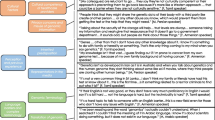Abstract
The aim of this pilot qualitative study was to describe the experiences and beliefs of medical interpreters when working with genetic counselors and other genetic providers caring for Hmong patients who are not native English speakers. Specific goals were to identify interpreters’ thoughts and perceptions on (a) their roles during sessions, (b) unique challenges in a genetics session, (c) knowledge genetics providers need when working with Hmong patients and interpreters, and (d) supports and training needed to effectively interpret in a genetics setting. Hmong medical interpreters from Wisconsin and Minnesota were invited by email to participate in the study. Six were interviewed by telephone. Participants had worked with a variety of providers including geneticists, genetic counselors, primary care physicians, and oncologists. Factors identified by Hmong interpreters that made interpretation of content difficult in clinical genetics sessions included: time constraints, technical terms, and unique cultural perspectives of Hmong patients. While all respondents felt their primary role was to interpret session content as close to verbatim as possible, there was notable variation in the description of their interpretation style and other perceived roles in the genetic counseling session. Cultural issues genetics providers could consider when working with Hmong patients and different style issues when working with Hmong interpreters are discussed. Ideas for future studies and suggestions to improve communication with Hmong patients are explored.
Similar content being viewed by others
References
Agather, A., Rietzler, J., Reiser, C. A., & Petty, E. M. (2017). Working with the Hmong Population in a Genetics Setting: Genetic Counselor Perspectives. Journal of Genetic Counseling, 1–13. https://doi.org/10.1007/s10897-017-0117-4.
Barrett, B., Shadick, R. N., Schilling, R., Spencer, L., del Rosario, R. D., Moua, S., & Vang, M. (1998). Hmong/medicine interactions: improving cross-cultural health care. Family Medicine, 30(3), 179–184.
Butow, P. N., Lobb, E., Jefford, M., Goldstein, D., Eisenbruch, M., Girgis, A., & Schofield, P. (2012). A bridge between cultures: interpreters’ perspectives of consultations with migrant oncology patients. Supportive Care in Cancer, 20(2), 235–244.
Certified Commission for Healthcare Interpreters (2014). Retrieved from http://www.cchicertification.org.
Elo, S., et al. (2008). The qualitative content analysis process. Journal of Advanced Nursing, 62(1), 107–115.
Hsieh, E., & Kramer, E. M. (2012). Medical interpreters as tools: dangers and challenges in the utilitarian approach to interpreters’ roles and functions. Patient Education and Counseling, 89(1), 158–162.
Hsieh, E., Pitaloka, D., & Johnson, A. J. (2013). Bilingual health communication: distinctive needs of providers from five specialties. Health Communication, 28(6), 557–567.
Jacobs, E., Chen, A. H., Karliner, L. S., Agger-Gupta, N., & Mutha, S. (2006). The need for more research on language barriers in health care: a proposed research agenda. Milbank Quarterly, 84(1), 111–133.
Lee, H. Y., & Vang, S. (2010). Barriers to cancer screening in Hmong Americans: the influence of health care accessibility, culture, and cancer literacy. Journal of Community Health, 35(3), 302–314.
Lewis, L. J. (2002). Models of genetic counseling and their effects on multicultural genetic counseling. Journal of Genetic Counseling, 11(3), 193–212.
National Council on Interpreting in Health Care (2013). Washington DC: Retrieved from http://www.ncihc.org/faq.
National Standards of Practice for Interpreters in Health Care (2005). Commonwealth fund. Retrieved from http://www.ncihc.org/assets/documents/publications/NCIHC National Standards of Practice.pdf.
Smalkoski, K., Herther, N. K., Xiong, Z. B., Ritsema, K., Vang, R., & Zhenh, R. (2012). Health disparities research in the Hmong American community: implications for practice and policy. Hmong Studies Journal, 13(2), 1–31.
Thomson, S. C. (2010). Medical interpreters can save money, lives. Certification remains unresolved. Health Progress (Saint Louis, Mo.), 91(4), 28.
U. S. Census Bureau American Community Survey (2012). American FactFinder fact sheet: allegany County, N.Y. Retrieved April 28, 2014, from http://factfinder2.census.gov/faces/tableservices/jsf/pages/productview.xhtml? pid=ACS_12_5YR_B16001&prodType=table.
U.S. Census Hmong Populations (2010). Hmong National Development Inc.
van Calcar, S. C., Gleason, L. A., Lindh, H., Hoffman, G., Rhead, W., Vockley, G., et al. (2007). 2-methylbutyryl-CoA dehydrogenase deficiency in Hmong infants identified by expanded newborn screen. WMJ-Madison, 106(1), 12.
Wilder Research Center. (2000). Speaking for themselves: a survey of Hispanic, Hmong, Russian, and Somali immigrants in Minneapolis-Saint Paul. Saint Paul: Amherst H. Wilder Foundation.
Wisconsin Court System (2014). How to get certified. Retrieved from: https://www.wicourts.gov/services/interpreter/certification.htm.
Xiong, A. (2011). Hmong medical interpreters meet to develop Hmong medical terminology. Hmong times online. Retrieved from http://www.hmongtimes.com/main.asp?SectionID=31&SubSectionID=190&ArticleID=3188.
Youdelman, M. (2013). The development of certification for healthcare interpreters in the United States. Translation & Interpreting, 5(1), 114-126.
Acknowledgements
Thank you to Shiva Bidar-Sielaff, MA and Chia Youyee Yang, PhD for providing information on Hmong medical interpreters and feedback on interview questions. Thank you to Jane Sheldon, PhD on her critique and helpful feedback manuscript preparation. This work was conducted to fulfull a degree requirement for the Genetic Counselor Training Program at the University of Wisconsin School of Medicine and Public Health.
Author information
Authors and Affiliations
Corresponding author
Ethics declarations
Conflict of Interest
Meghan Krieger, Kathryn Douglas, Aime Agather, Catherine A. Reiser and Elizabeth M. Petty declare they have no conflict of interest.
Human Studies and Informed Consent
All procedures followed were in accordance with the ethical standards of the responsible committee on human experimentation (institutional and national) and with the Helsinki Declaration of 1975, as revised in 200 (5). Informed consent was obtained from all subjects of being included in the study. (Project number: 2013-1065).
Animal Studies
No animal studies were carried out by the authors for this article.
Rights and permissions
About this article
Cite this article
Krieger, M., Agather, A., Douglass, K. et al. Working with the Hmong Population in a Genetics Setting: an Interpreter Perspective. J Genet Counsel 27, 565–573 (2018). https://doi.org/10.1007/s10897-017-0153-0
Received:
Accepted:
Published:
Issue Date:
DOI: https://doi.org/10.1007/s10897-017-0153-0



